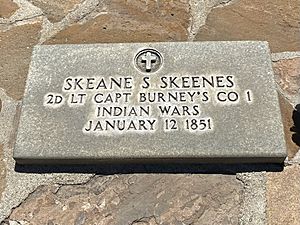Mariposa War facts for kids
The Mariposa War was a conflict that happened in central California between Native Americans and miners. It took place from December 1850 to June 1851 in an area called Mariposa. This war started because of the California Gold Rush. Thousands of new settlers and gold seekers came into Native American lands through the California Trail. During the war, a special group called the Mariposa Battalion attacked and destroyed many Native American villages. The Mariposa War is also seen as part of the California genocide, a time when many indigenous peoples of California lost their lives due to actions by the United States government and private citizens.
Contents
Why the War Started
The main reason for the Mariposa War was the California Gold Rush. After gold was found on January 24, 1848, many people rushed to California. By May 1849, over 40,000 gold seekers had traveled the California Trail. They entered northern and central California, which was home to Native Americans and Californios (people of Spanish descent).
The number of non-Native American people in California grew very fast. It went from 14,000 in 1848 to 200,000 by 1852. These new arrivals came from places like Mexico, South America, Europe, Australia, and China.
Miners looking for gold often forced Native Americans off their traditional lands. Some Native Americans were also made to work in the mines. Their villages were sometimes attacked by the army or volunteer groups. In December 1850, the Ahwahneechees and the Chowchilla tribes in the Sierra Nevada mountains and San Joaquin Valley fought back. They raided a trading post on the Fresno River that belonged to James D. Savage.

After this raid, James Savage, with help from Mariposa County Sheriff James Burney, led a group of 74 men. They attacked a Chowchilla camp on the Fresno River near what is now Oakhurst, California. This happened on January 11, 1851. Savage's men attacked at dawn, but they were surprised when the Chowchilla fought back with their own rifles and pistols. Savage's group was not ready for this and scattered. The Native Americans won this first battle of the Mariposa War.
The Mariposa War Campaigns
Forming the Mariposa Battalion
After the first battle, Sheriff James Burney asked for help from John McDougal, who was the second Governor of California. This led to the creation of the Mariposa Battalion. This was a state militia group led by "Major" James D. Savage. It had three main companies:
- Company A: 70 men, led by Captain John J. Kuykendall
- Company B: 72 men, led by Captain John Boling
- Company C: 56 men, led by Captain William Dill
At the same time, officials from the United States government tried to find a peaceful solution. On March 19, 1851, they signed a treaty at Camp Fremont near Mariposa Creek with six different tribes. However, the Ahwahneechees and Chowchillas were not part of these talks. So, a military campaign against them began on the very same day.
First Military Campaign
The first military action started when Company A, led by Captain Kuykendall, traveled south to the King's and upper Kaweah Rivers, and into the Tulare Valley. When they reached the King's River, their scouts found a large Chowchilla village nearby. Company A charged into the village, and many Native Americans were killed. Some survivors were chased, caught, and taken prisoner. However, because Kuykendall's men left their horses to attack the village, many Chowchilla people were able to escape on foot.
After the village attack, Kuykendall's group moved to the headwaters of the Kahweah River, but they could not find any more Chowchilla people. A few days later, a group of Chowchilla came to their camp to ask for peace. The peace offer was accepted, and plans were made to move the surviving Chowchilla to a reservation on the San Joaquin River. After this, Kuykendall returned to the battalion's main camp on Mariposa Creek in early April.
Meanwhile, Companies B and C, led by Boling and Dill, chased Native Americans into the mountains. These units often had to march through rain, sleet, and deep snow. On March 27, they found a refuge used by the Ahwahneechees in Yosemite Valley, but there were only a few Native Americans there.
Second Military Campaign
On April 13, a new campaign was launched against the Chowchilla tribe. Units from the Mariposa Battalion destroyed the tribe's food supplies. However, most Native Americans were able to avoid the militia groups. But after their chief died, the remaining Chowchilla surrendered. They were then moved to a reservation.
Third Military Campaign
The Ahwahneechees refused to come to Camp Barbour for talks. So, the Californian government started a third campaign against them. The Mariposa Battalion surrounded the Ahwahneechees at Lake Tenaija on May 22. This lake was named after their chief, Tenaya. With little chance of winning, the tribe agreed to surrender Yosemite Valley and the surrounding areas to the Californian government. The Battalion then acted as guards and marched the Native Americans to the Fresno River Farm Reservation. After the Ahwahneechees were settled on the reservation, the militia returned to the Mariposa Creek post.
The Mariposa Battalion was officially disbanded on July 1, 1852.
See also
 In Spanish: Guerra Mariposa para niños
In Spanish: Guerra Mariposa para niños

